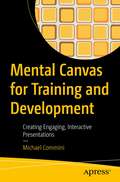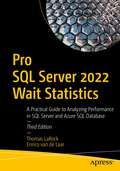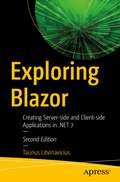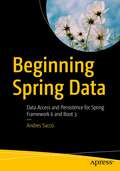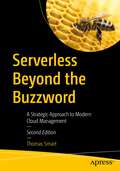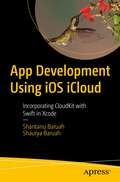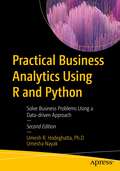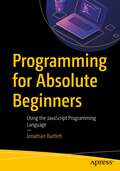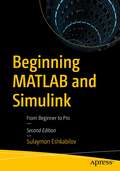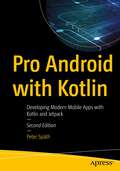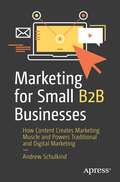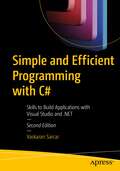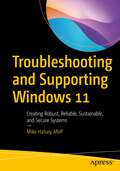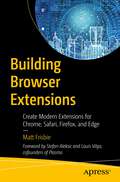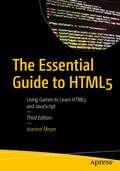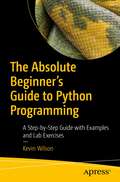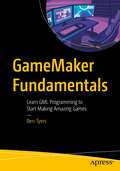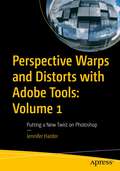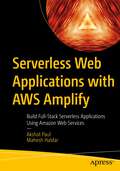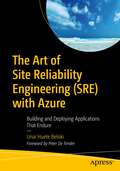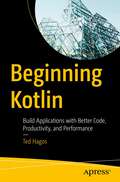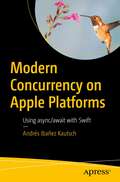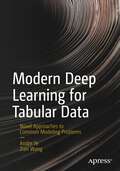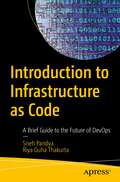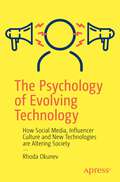- Table View
- List View
Mental Canvas for Training and Development: Creating Engaging, Interactive Presentations
by Michael ComminiTake advantage of layering and other digital techniques to create stunning, interactive compositions suitable for delivering instructional content and presentations on your iOS or Android device. This book shows you how to move from traditional paper and pen drawing to 3D content that can be interacted with by the viewer. Designed to be used on tablets, the Mental Canvas app is a reimagining of presentation software in the digital age that uses patented technology developed by a research team at Yale University. Whether producing concept drawings, storyboards, tutorials, sales presentations, or other forms of interactive media, you’ll learn the skills to transform boring presentations into something exciting and new! You’ll create stunning panoramic views; allow viewers to move through your artwork with multiple scenes; publish to the web for viewing on any smart phone, tablet, or computer; import image files; and export animated fly-throughs as .mp4 files. Mental Canvas can be used by individual creatives or as part of a collaborative design team sharing files between multiple devices giving global instructional design firms an edge over their competition. Provide fun, interactive, and engaging presentations and throw out those boring click-through, static presentations of the past. Business Dashboards, Organizational About Us pages, Sales presentations – virtually whatever the organization’s creatives can think up you’ll learn to develop in Mental Canvas!What You'll LearnUse layering to create stunning 3D effects in an otherwise static 2D imageImport and adapt existing images into your dynamic presentationCreate .mp4 fly-throughs that bring websites and presentations to life with videoWho This Book Is ForAny creative who wishes to build engaging and interactive presentations with their iOS or Android device.
Pro SQL Server 2022 Wait Statistics: A Practical Guide to Analyzing Performance in SQL Server and Azure SQL Database
by Thomas LaRock Enrico van de LaarUse this practical guide to analyze and troubleshoot SQL Server performance using wait statistics. You'll learn to identify precisely why your queries are running slowly. And you'll know how to measure the amount of time consumed by each bottleneck so you can focus attention on making the largest improvements first. This edition is updated to cover analysis of wait statistics current with SQL Server 2022. Whether you are new to wait statistics, or already familiar with them, this book provides a deeper understanding on how wait statistics are generated and what they mean for your SQL Server instance’s performance. The book goes beyond the most common wait types into the more complex and performance-threatening wait types. You’ll learn about per-query wait statistics and session-based wait statistics, and the types of problems they can help you solve. The different wait types are categorized by their area of impact, including CPU, IO, Latching, Locking, and many more.Clear examples are included to help you gain practical knowledge of why and how specific wait times increase or decrease, how they impact your SQL Server’s performance, and what you can do to improve performance. After reading this book, you won’t want to be without the valuable information that wait statistics provide regarding where you should be spending your limited tuning time to maximize performance and value to your business. What You'll LearnUnderstand how the SQL Server engine processes requestsIdentify resource bottlenecks in a running SQL Server instanceLocate wait statistics information inside DMVs and Query StoreAnalyze the root cause of sub-optimal performanceDiagnose I/O contention and locking contentionBenchmark SQL Server performanceImprove database performance by lowering overall wait time Who This Book Is ForDatabase administrators who want to identify and resolve performance bottlenecks, those who want to learn more about how the SQL Server engine accesses and uses resources inside SQL Server, and administrators concerned with achieving—and knowing they have achieved—optimal performance
Exploring Blazor: Creating Server-side and Client-side Applications in .NET 7
by Taurius LitvinaviciusBuild and develop web applications with Blazor in C#. This book covers both server-side and client-side Blazor, along with its latest features and the structure of the technology. You’ll see that Blazor is a web UI framework based on C#, Razor, and HTML, and how it runs front-end logic using C#, either on the server or on the browser, using WebAssembly. This new edition not only covers the new structure for the Blazor environment, it also demonstrates the latest features, such as adding API features to a Blazor server project; creating code-behind files for C# and CSS; new ways to pick, save, and handle files in Blazor; and much more. The code and project layout have been updated in .NET 7 for this new edition. The book starts with an introduction to Blazor, along with its various categories and its basics and syntax, including Razor syntax implementation. You will go through Blazor navigation and components, and learn its life cycle events and other components. You will learn features specific to each Blazor type. You will see how Blazor works with storage, files, and JavaScript, and you will create a Blazor code library. You will also create web applications in Blazor using practical implementations and real-life scenarios for both the server side and the client side.After reading this book, you will be able to build web applications with Blazor in C#11 and .NET Core 7.0.What You Will LearnBind data and handle events in C# BlazorHandle components and page navigation in BlazorConnect Blazor front-end to APIsInteract with files using BlazorUnderstand the layout of Visual Studio Blazor project templates Who This Book Is For C# and .NET Core developers.
Beginning Spring Data: Data Access and Persistence for Spring Framework 6 and Boot 3
by Andres SaccoUse the popular Spring Data project for data access and persistence using various Java-based APIs such as JDBC, JPA, MongoDB, and more. This book shows how to easily incorporate data persistence and accessibility into your microservices, cloud-native applications, and monolithic enterprise applications. It also teaches you how to perform unit and performance testing of a component that accesses a database. And it walks you through an example of each type of SQL and NoSQL database covered. After reading this book, you’ll be able to create an application that interacts with one or multiple types of databases, and conduct unit and performance testing to analyze possible problems. Source code is available on GitHub.What You’ll LearnBecome familiar with the Spring Data project and its modules for data access and persistenceExplore various SQL and NoSQL persistence typesUncover the persistence and domain models, and handle transaction management for SQLMigrate database changes and versioning for SQLDive into NoSQL persistence with Redis, MongoDB, Neo4j, and CassandraHandle reactive database programming and access with R2DBC and MongoDBConduct unit, integration, and performance testing, and moreWho This Book Is ForExperienced Java software application developers; programmers with experience using the Spring framework or the Spring Boot micro framework
Serverless Beyond the Buzzword: A Strategic Approach to Modern Cloud Management
by Thomas SmartKnow how Serverless and cloud-native systems work, their benefits and roles in automating and optimizing organizations, and the challenges to be considered. Anyone interested in Serverless architecture will benefit from this book, regardless of their level of technical understanding. This revised and expanded new edition explains many related terms, such as microservices, cloud-native, architecture, several relevant AWS services, and how it all works together to produce cost-effective, scalable solutions in the cloud. The book starts at a high level and gradually gets more in-depth and technical.The less technical decision maker will learn how Serverless can affect finance, security, people, and compliance. The book touches on important decisions, such as selecting and working with external or internal specialists and teams; finding, evaluating, and training them; and the flexibility and dynamics available within digital projects. Deployment automation and DevOps also feature heavily in this book, and you will find real-world use cases and examples of Serverless architecture to get you started. It's worth noting that this book is not a development guide; it gives you a comprehensive understanding of what Serverless is so you can make informed decisions for your organization and projects. What You’ll Learn Understand Serverless architecture and strategyUnderstand modern cloud management strategy, governance, and organizational team structureHandle budget planning and managementGet started with Serverless architecture designGain knowledge of best practices and security, as well as data management and DevOpsStudy proactive logging, operations, architecture examples, case studies, and more Who This Book Is For Anyone interested in a deep understanding of Serverless and how it can impact organizations and projects, regardless of their technical level. Strategic insights are provided for entrepreneurs and executives, planning and team insights for project managers, and technical insights for architects and team leads. Cloud consultants working with enterprises can read everything for a full, in-depth understanding of the topic. Other readers, such as less technical CTOs/CIOs, VPs, entrepreneurs, product owners, project managers, etc., can get what they need from the first 5-7 chapters. More technical readers and those experienced with Serverless can skim through the first 3 chapters and start with the security deep dive in Chapter 4.
App Development Using iOS iCloud: Incorporating CloudKit with Swift in Xcode
by Shantanu Baruah Shaurya BaruahCreate a professional looking app from start to finish that takes advantage of iCloud technology. Rather than working with Storyboarding for building your UI, you’ll use code to build professional looking screens. Using code is standard for professional developers to fit form factor alignment across multiple screen sizes and other design constraints.First, you’ll build a basic, functional UX screen. Then you’ll incorporate iCloud with CloudKit for data persistence and private, public, and shared databases. Here your code-drive UI design will expand out to developing professional looking screens with animation. You’ll also learn to work with reminder and notification boxes, sharing data between your users, and adding functionally for interaction with other Apps. Finally, you’ll tackle testing and using Test Flight before publishing your app to the App Store. This book offers a practical guide for coders at any level who want to learn and create professional looking iOS apps leveraging the database features of iCloud and the numerous extensions that Apple provides in the Xcode environment. Create professional looking apps that are secure and your users will love! What You'll LearnLeverage CloudKit for Backend as a ServiceHandle Asynchronous processesShare data among users of your app with simultaneous modificationsWho This Book Is ForiOS developers familiar with the basics of Swift coding who want to work with iCloud databases or move into more advanced fields, such as using extensions or designing UX in code.
Practical Business Analytics Using R and Python: Solve Business Problems Using a Data-driven Approach
by Umesh R. Hodeghatta Umesha NayakThis book illustrates how data can be useful in solving business problems. It explores various analytics techniques for using data to discover hidden patterns and relationships, predict future outcomes, optimize efficiency and improve the performance of organizations. You’ll learn how to analyze data by applying concepts of statistics, probability theory, and linear algebra. In this new edition, both R and Python are used to demonstrate these analyses. Practical Business Analytics Using R and Python also features new chapters covering databases, SQL, Neural networks, Text Analytics, and Natural Language Processing.Part one begins with an introduction to analytics, the foundations required to perform data analytics, and explains different analytics terms and concepts such as databases and SQL, basic statistics, probability theory, and data exploration. Part two introduces predictive models using statistical machine learning and discusses concepts like regression, classification, and neural networks. Part three covers two of the most popular unsupervised learning techniques, clustering and association mining, as well as text mining and natural language processing (NLP). The book concludes with an overview of big data analytics, R and Python essentials for analytics including libraries such as pandas and NumPy.Upon completing this book, you will understand how to improve business outcomes by leveraging R and Python for data analytics.What You Will LearnMaster the mathematical foundations required for business analyticsUnderstand various analytics models and data mining techniques such as regression, supervised machine learning algorithms for modeling, unsupervised modeling techniques, and how to choose the correct algorithm for analysis in any given taskUse R and Python to develop descriptive models, predictive models, and optimize modelsInterpret and recommend actions based on analytical model outcomes Who This Book Is For Software professionals and developers, managers, and executives who want to understand and learn the fundamentals of analytics using R and Python.
Programming for Absolute Beginners: Using the JavaScript Programming Language
by Jonathan BartlettNew programmers start here...this book introduces students or aspiring professionals to the world of computer programming using JavaScript and related technologies. This book doesn't just teach the basics of programming, but also all of the tools that new programmers need to get started, including the basics of making web pages and how the Internet works. Programming for Absolute Beginners offers practice problems, activities, and a host of resources to get new programmers started, plus a large glossary of terms introduced in the book and that a new programmer might encounter when learning on their own. No special software is required; this book will help you regardless of what your computer setup is, and source code will be freely available via GitHub.What You Will LearnHow computers workHow computers communicate over networksHow web pages are built with HTML and CSSHow JavaScript worksHow JavaScript interacts with web pagesIntermediate JavaScript topics such as recursion and scopingUsing JavaScript for network communication Who This Book Is ForAnyone wanting to begin computer programming, including students who need to learn the fundamentals and early professionals who want to go back and revisit the basics.
Beginning MATLAB and Simulink: From Beginner to Pro
by Sulaymon EshkabilovEmploy essential tools and functions of the MATLAB and Simulink packages, which are explained and demonstrated via interactive examples and case studies. This revised edition covers features from the latest MATLAB 2022b release, as well as other features that have been released since the first edition published. This book contains dozens of simulation models and solved problems via m-files/scripts and Simulink models which will help you to learn programming and modelling essentials. You’ll become efficient with many of the built-in tools and functions of MATLAB/Simulink while solving engineering and scientific computing problems. Beginning MATLAB and Simulink, Second Edition explains various practical issues of programming and modelling in parallel by comparing MATLAB and Simulink. After studying and using this book, you'll be proficient at using MATLAB and Simulink and applying the source code and models from the book's examples as templates for your own projects in data science or engineering. What You Will LearnMaster the programming and modelling essentials of MATLAB and SimulinkCarry out data visualization with MATLABBuild a GUI and develop App with MATLABWork with integration and numerical root finding methodsApply MATLAB to differential equations-based models and simulationsUse MATLAB and Simulink for data science projects Who This Book Is ForEngineers, programmers, data scientists, and students majoring in engineering and scientific computing who are new to MATLAB and Simulink.
Pro Android with Kotlin: Developing Modern Mobile Apps with Kotlin and Jetpack
by Peter SpäthDevelop Android apps with Kotlin to create more elegant programs than the Java equivalent. This revised book covers the various aspects of a modern Android app that professionals are expected to encounter. You'll use the latest Kotlin APIs as made available in most recent versions of the Android SDK. There are chapters dealing with all the important aspects of the Android platform, including GUI design, file- and data-handling, coping with phone calls, multimedia apps, interaction with location and mapping services, monetizing apps, and much more. Jetpack will also be covered. It is a suite of libraries to help developers follow best practices, reduce boilerplate code, and write code that works consistently across Android versions and devices.Pro Android with Kotlin, Second Edition is an invaluable source for developers wanting to build real-world, state-of-the-art Android apps for modern Android devices using the Kotlin programming language and its APIs as available in the modern Android SDK. After reading this book, you'll come away with the skills and techniques to build modern Android apps that you can sell on Google Play. Free source code is available on this book's Github page as well. What You Will LearnIntegrate activities, such as intents, services, notifications and more, into your Android appsBuild UIs in Android using layouts, widgets, lists, menus, and action barsDeal with data in your Android apps using data persistence and cloud accessDesign for different Android devicesCreate multimedia apps in AndroidSecure, deploy, and monetize your Android appsWho This Book Is ForProfessional Android app developers.
Marketing for Small B2B Businesses: How Content Creates Marketing Muscle and Powers Traditional and Digital Marketing
by Andrew SchulkindSmall business marketers don’t need to understand technical minutia of websites or the high-level social media strategies of national consumer brands. They need to understand how to build successful marketing machines that they can sustain with the resources they have available. This book will help small-business B2B marketers build a strong digital presence that will drive growth. Most B2B buyers are about two-thirds of the way through their purchase process before they are willing to engage with a salesperson. Therefore, having a strong digital presence is the difference between making your prospect’s short list and your prospect not even knowing you exist. Most critically, a strong digital presence relies on content written from your audience’s perspective. This book provides insight and information about the questions that are critical to their business and that you can help them solve. It is the key to capturing their attention, gaining their trust, and winning their business. Marketing can’t work its magic alone. It needs the support of strong branding and must provide support to well-executed sales processes. Marketing for Small B2B Businesses will dive into the relationship between each of these areas. What You'll LearnBuild a website that serves as the hub of your marketingEstablish a content promotion plan that puts your content in front of the right audienceDevelop strategies and tactical plans for finding the channels best suited to your message such as social media and email marketing Create effective content in a timely manner with the resources you have availableTrack what is working and what needs improvement via an analytics platform to consistently produce strong marketing returnsWho This Book Is ForThe primary audience is B2B small business owners and B2B small business marketing leaders.
Simple and Efficient Programming with C#: Skills to Build Applications with Visual Studio and .NET
by Vaskaran SarcarApply skills and approaches to your programming to build a real-world application in C# 11 using the latest editions of Visual Studio, C#, and Microsoft .NET.This revised edition is updated with C#11 and places more emphasis on the newly introduced top-level statements. Additionally, you will find useful techniques and an explanation of the differences between writing code in two different styles. It also covers the new templates introduced in .NET 6, along with usage of .NET 7 in Windows 10 to write code and generate output. Each chapter opens with an introduction and original application written in C# 11 so that you can jump right into coding. From there, you are guided through an expected output and taught best practices along the way. Author Vaskaran Sarcar emphasizes extending and maintaining the same program and he demonstrates examples for different scenarios to make your program more efficient and effective. This book is divided into five parts. The first part starts with a detailed discussion of polymorphism. It then shows you how to make proper use of abstract classes and interfaces, and teaches you to discern which technique to use for a specific scenario. Discussions on code comments teach you how to use them effectively, and why you need to be careful with code comments. In the second part you will learn six design principles, including SOLID and DRY principles. These are the foundation of well-known design patterns, and they establish practices for developing software with considerations for maintaining and extending as a project grows. The third part walks you through methods to make efficient applications. You will learn the common use of factories to separate code from its opposite and the alternative of inheritance using object composition and wrappers. This part also demonstrates the use of template methods, hooks, and facades in programming. Hints show you how professional coders develop an enterprise application.Better handling of exceptions and null values is another integral part of professional programming, which the fourth part explores in detail. This will help you become a more professional programmer.In the final part of the book, you will learn about effective memory management techniques and the use and misuse of design patterns. This part also briefly discusses how to decide between a static method and an instance method and other techniques. After reading this book, you will be able to implement best practices to make your programs more effective and reliable.What Will You LearnAnalyze alternative solutions before implementation by comparing pros and consMake polymorphic code perform betterKnow the side effects of bad/redundant commentsUnderstand the significance of the SOLID and DRY principlesAdd features using wrappersRedefine steps without altering the calling sequence of an algorithmUse hooks in your applicationConvert a complex system into a user-friendly system using facades Run your application in .NET 6 Who Is This Book ForDevelopers with a basic knowledge of C#.
Troubleshooting and Supporting Windows 11: Creating Robust, Reliable, Sustainable, and Secure Systems
by Mike HalseyDiagnose, troubleshoot and repair any type of problems on your PC from startup and file access to cloud services and the issues caused by hybrid-work. This book contains everything you need to know to keep PC systems running optimally, and to repair problems quickly and efficiently. This book provides a deep dive into the Windows OS, detailing what everything is, and how it works. You will learn about the in-built, additional, and third-party tools and utilities you can use to create reliable, robust and secure PC systems. Further, you will learn how to configure Windows 11 so as to avoid problems occurring, and how to support every type of end user, working from home, or in any part of the world, speaking any language, and taking into account other factors such as ability or personal barriers. You will discover the support tools and support ecosystem you can use to create and manage effective support tracking and remote access. You will discover how to get detailed events and reliability information, and how to manage update channels. You will deep dive into Windows 11 operating system and folder structure and learn app and software troubleshooting, process and service troubleshooting, network and internet troubleshooting and hardware and peripherals troubleshooting. Finally, you will learn more advanced troubleshooting techniques like security and encryption troubleshooting and using PowerShell scripting to repair problems. Further, you will also learn how to manually remove malware and ransomware, registry troubleshooting and startup and repair troubleshooting. By the end, you will know how to troubleshoot complex problems and diagnose hardware problems in a PC. You will be able to troubleshoot and repair any type of problem on a Windows 11 PC. What Will You Learn How to support home and hybrid-workers using their own PCsUsing scripting and PowerShell to troubleshoot and repair systemsManaging networking and internet access to minimize downtimeManaging installation and troubleshoot for updates and patches Who Is This Book For IT Pros and system administrators who have to maintain small or large networks of connected PCs locally at their organization, or with hybrid workers.
Building Browser Extensions: Create Modern Extensions for Chrome, Safari, Firefox, and Edge
by Matt FrisbieAlmost all web developers today have plenty of experience with building regular web page apps, but a lot of that knowledge doesn't transfer over when it comes to creating browser extensions. This book provides a complete reference for how to build modern browser extensions. Creating and deploying a browser extension is more like building a mobile app than a website. When you start building an extension you'll often find there are a large number of new concepts and idiosyncrasies to wrangle with. This book reveals how to successfully navigate around these obstacles and how to take advantage of the limited resources available. You'll see how a browser extensions work, their component pieces, and how to build and deploy them. Additionally, you'll review all the tricky bits of extension development that most developers have to learn through trial and error. The current transition from manifest v2 to v3 is of special interest, and an entire chapter will be dedicated to this subject. By the end of this book, you will have a rich understanding of what browser extensions are, how they work, all the pitfalls to avoid, and the most efficient ways of building them.What You’ll LearnExamine the different components of browser extensions and how they behaveReview common pitfalls developers encounter when building browser extensions and how to avoid themDevelop, deploy, and manage a published browser extensionBuild a browser extension using modern JavaScript frameworksWho This Book Is ForDevelopers tasked with building a supplementary browser extension to go alongside their existing product. This book also targets people that have at least a basic understanding of the fundamentals of web development and wish to quickly understand how they can roll out a browser extension.
The Essential Guide to HTML5: Using Games to Learn HTML5 and JavaScript
by Jeanine MeyerGain a deep, practical knowledge of the basic tools used for webpages: hypertext markup language (HTML5), cascading style sheets (CSS), and JavaScript. This updated version includes new and improved games and exercises, and will serve total beginners as well as people with some programming language experience, but not familiar with the combination of HTML, CSS, and JavaScript.You'll begin at an introductory level with the focus on technical features as well as programming techniques. Each chapter features a familiar game such as Rock-Paper-Scissors, Craps, Memory, and Blackjack or generic examples such as working with Mazes. Other projects include constructing and saving a maze; a basic word guessing game; ballistic games (Cannonball and Slingshot); a quiz requiring items to be put in order; and an animation demonstration featuring a ball, photo or video clip bouncing within a rectangle. The Appendix contains examples of advanced techniques such as Scalar Vector Graphics programs displaying the HTML5 Logo and a cartoon figure, each of which can be changed dynamically, and mathematical techniques for calculating if a move crosses a line and re-adjusting an arrangement of circles and arrows. The exposition on each example in the chapters and the Appendix includes screen shots and tables revealing the structure of the program and statement by statement explanation of code.The book also contains suggestions for using the concepts and techniques to build your own programs. If you follow through with your own ideas, you will develop solid programming skills for building websites and for learning other programming languages, including the next version of HTML and current and future JavaScript frameworks, libraries and tools.What You'll Learn Understand HTML 5 concepts with the help of easy-to-grasp, appealing examples Use HTML5 to explore new avenues for web application and game developmentReview important new elements of HTML 5 Build, test, and upload simple games to a web site Who This Book Is ForBoth absolute beginners and users with some knowledge of HTML who want to learn the new HTML5 features
The Absolute Beginner's Guide to Python Programming: A Step-by-Step Guide with Examples and Lab Exercises
by Kevin WilsonWritten as an illustrated, step-by-step guide, this book will introduce you to Python with examples using the latest version of the language. You'll begin by learning to set up your Python environment. The next few chapters cover the basics of Python such as language classifications, Python language syntax, and how to write a program. Next, you will learn how to work with variables, basic data types, arithmetic, companion, and Boolean operators, followed by lab exercises. Further, the book covers flow control, using functions, and exception handling, as well as the principles of object-oriented programming and building an interface design. The last section explains how to develop a game by installing PyGame and how to use basic animation, and concludes with coverage of Python web development with web servers and Python web frameworks. The Absolute Beginners Guide to Python Programming will give you the tools, confidence, and inspiration to start writing Python programs. If you are a programmer, developer, or a student, or someone who wants to learn on their own, this book is for you.What You Will LearnGain an understanding of computer programming Understand different data and data typesWork with Classes and OOPBuild interfaces, simple games, and web development with PythonWho This Book Is ForSoftware programmers, developers or students, or anyone who wants to learn Python programming on their own.
GameMaker Fundamentals: Learn GML Programming to Start Making Amazing Games
by Ben TyersMaster the fundamental programming skills needed to create your own computer games in GameMaker. This book shows how to use GameMaker to build and publish cross-platform games. Each chapter covers a certain programming element, including layers, variables, and so on. You will also learn how to design levels in your games, draw sprites to populate your virtual worlds, and build GUIs for your menus and game interfaces. GameMaker Fundamentals also provides a thorough introduction to the GameMaker Language (GML). Practical example projects reinforce the concept discussed in each chapter. On completing this book, you will have a thorough understanding of how to create games from scratch using game design and programming principles using GameMaker and GML. What You Will LearnReview core programming features required for sound knowledge of GameMakerMaster how to combine GML to orchestrate game actionsUtilize GameMaker's layers to create exciting gamesSet up player controlWho Is This Book ForThose new to GameMaker or game programming in general; it assumes no prior knowledge or skill set.
Perspective Warps and Distorts with Adobe Tools: Putting a New Twist on Photoshop
by Jennifer HarderGain skills in image and logo manipulation that will enhance your designs and make them more appealing--either in your portfolio or for your client’s next graphic project.As Adobe's Photoshop and Illustrator have evolved, new and unique features have been added to these programs that offer different options for warping and distorting graphics and shapes. For the beginner and intermediate student or graphic artist, choosing or knowing which distort or warp tool to use among so many available can become overwhelming and confusing.This book primarily focuses on teaching how to work with various warping tools and filters in Photoshop, though you will also be using graphics acquired from Adobe Illustrator. Knowing how to work between these two applications is a crucial part of understanding how to successfully manipulate your designs. In Photoshop, you'll see how to alter both raster images and vector graphics, and learn how to do this with layers in various non-destructive ways. Some of the filters mentioned in this book will be familiar to you, as you may have used them frequently. However, others are well hidden, are new, or perhaps you have never considered that you could use that tool, dialog box, or filter to warp or distort. What You Will LearnBecome proficient in using the warping and distorting tools and filters in Photoshop, as well as how to correct basic distortions in photos and add perspectiveGrasp transferring illustrations from Illustrator for use in PhotoshopDiscover how to warp and distort typeGenerate unique patternsWork with Smart Object Layers and Smart FiltersWork in combination with older tools and newer, enhanced ones Who This Book Is ForBeginner- and Intermediate-level readers interested in pursuing careers as graphic artists, photographers, or video artists/animators.
Serverless Web Applications with AWS Amplify: Build Full-Stack Serverless Applications Using Amazon Web Services
by Akshat Paul Mahesh HaldarLearn the fundamentals of serverless applications and how to take advantage of time-tested Amazon Web Services (AWS) to build scalable apps. This book shows you how to work with the key features of your applications with minimum code, simple CLI commands and one-click deployments. You'll see how to manage authentication, standard UI components, database storage, filesystem, CI/CD pipeline and more. You'll also examine the architecture, strengths, scalability, and limitations of serverless, and how to use AWS Amplify effectively. You will use tools including React, Cognito, GraphQL, DynamoDB, Kinesis, and Sagemaker. AWS Amplify is the fastest and easiest way to build serverless web and mobile apps at scale, comprising tools and services that work independently and can be wired together to build scalable apps. What You'll Learn Build GraphQL and REST APIsModel data with Amplify DatastoresSet up a CI/CD pipeline with AmplifyRecord and make sense of user data analytics with KinesisBoost your application with AI/ML capability using Sagemaker Who This Book Is ForDevelopers who have worked on web technologies and want to learn how to build serverless applications and developers interested in making powerful applications using AWS that can then be wired using AWS Amplify.
The Art of Site Reliability Engineering (SRE) with Azure: Building and Deploying Applications That Endure
by Unai Huete BelokiGain a foundational understanding of SRE and learn its basic concepts and architectural best practices for deploying Azure IaaS, PaaS, and microservices-based resilient architectures. The book starts with the base concepts of SRE operations and developer needs, followed by definitions and acronyms of Service Level Agreements in real-world scenarios. Moving forward, you will learn how to build resilient IaaS solutions, PaaS solutions, and microservices architecture in Azure. Here you will go through Azure reference architecture for high-available storage, networking and virtual machine computing, describing Availability Sets and Zones and Scale Sets as main scenarios. You will explore similar reference architectures for Platform Services such as App Services with Web Apps, and work with data solutions like Azure SQL and Azure Cosmos DB. Next, you will learn automation to enable SRE with Azure DevOps Pipelines and GitHub Actions. You’ll also gain an understanding of how an open culture around post-mortems dramatically helps in optimizing SRE and the overall company culture around managing and running IT systems and application workloads. You’ll be exposed to incent management and monitoring practices, by making use of Azure Monitor/Log Analytics/Grafana, which forms the foundation of monitoring Azure and Hybrid-running workloads. As an extra, the book covers two new testing solutions: Azure Chaos Studio and Azure Load Testing. These solutions will make it easier to test the resilience of your services. After reading this book, you will understand the underlying concepts of SRE and its implementation using Azure public cloud.What Will You Learn:Learn SRE definitions and metrics like SLI/SLO/SLA, Error Budget, toil, MTTR, MTTF, and MTBFUnderstand Azure Well-Architected Framework (WAF) and Disaster Recovery scenarios on AzureUnderstand resiliency and how to design resilient solutions in Azure for different architecture types and servicesMaster core DevOps concepts and the difference between SRE and tools like Azure DevOps and GitHubUtilize Azure observability tools like Azure Monitor, Application Insights, KQL or GrafanaUnderstand Incident Response and Blameless Post-Mortems and how to improve collaboration using ChatOps practices with Microsoft tools Who Is This Book For:IT operations administrators, engineers, security team members, as well as developers or DevOps engineers.
Beginning Kotlin: Build Applications with Better Code, Productivity, and Performance
by Ted HagosThis book introduces the Kotlin programming skills and techniques necessary for building applications. You'll learn how to migrate your Java programming skills to Kotlin, a Java Virtual Machine (JVM) programming language.The book starts with a quick tour of the Kotlin language and gradually walks you through the language in greater detail over the course of succeeding chapters. You’ll learn Kotlin fundamentals like generics, functional programming, type system, debugging, and unit testing. Additionally, with the book’s freely downloadable online appendices, you’ll discover how to use Kotlin for building Spring Boot applications, data persistence, and microservices. What You Will LearnLearn the Kotlin language, its functions, types, collections, generics, classes, and moreDive into higher-order functions, generics, debugging, and unit testingApply the fundamentals of Kotlin to Spring Boot Add Hibernate to your Spring Boot application for persistence and data accessibility Take advantage of functional programming available in KotlinWho This Book Is ForJava developers who are new to Kotlin and want to leverage Kotlin, particularly for building Spring Boot apps.
Modern Concurrency on Apple Platforms: Using async/await with Swift
by Andrés Ibañez KautschBuild solid software with modern and safe concurrency features. Concurrency is one of the hardest problems in computer science. For years, computer scientists and engineers have developed different strategies for dealing with concurrency. However, the original concurrency primitives are complicated and difficult to understand, and even harder to implement. Using the new async/await APIs in Swift, this book will explain how your code can abstract a lot of the complexity with a simpler interface so you never have to deal with concurrency primitives such as semaphores, locks, and threads yourself. This will allow you to write concurrent code that is easier to read, easier to write, and easier to maintain. These new APIs are deeply ingrained into Swift, offering compile-level features that will keep you from writing dangerous concurrent code. You’ll start by exploring why concurrency is hard to implement in a traditional system. Explaining the definition of concurrency and what its primitives are will help you understand why they are hard to use correctly. These concepts will become clearer as you work through the sample projects. The book’s focus then shifts exclusively to the new APIs, helping you understand how the integration of the system with the language itself makes it easier for you to write concurrent code without overstepping the bounds of the concurrency safe zone. By the end of the book, you’ll have a solid foundation for working safely with concurrent code using the new async/await APIs.What You'll LearnUnderstand concurrency and its traditional problems Work with the new async/await API and all its features, from the basic usage and await keywords, to task groups and async sequences.Implement modern and safe concurrent code that you can start using right awayWho This Book Is For Experienced iOS developers at a semi-senior or senior level. Knowledge on the Grand Central Dispatch is a bonus, but not required.
Modern Deep Learning for Tabular Data: Novel Approaches to Common Modeling Problems
by Andre Ye Zian WangDeep learning is one of the most powerful tools in the modern artificial intelligence landscape. While having been predominantly applied to highly specialized image, text, and signal datasets, this book synthesizes and presents novel deep learning approaches to a seemingly unlikely domain – tabular data. Whether for finance, business, security, medicine, or countless other domain, deep learning can help mine and model complex patterns in tabular data – an incredibly ubiquitous form of structured data. Part I of the book offers a rigorous overview of machine learning principles, algorithms, and implementation skills relevant to holistically modeling and manipulating tabular data. Part II studies five dominant deep learning model designs – Artificial Neural Networks, Convolutional Neural Networks, Recurrent Neural Networks, Attention and Transformers, and Tree-Rooted Networks – through both their ‘default’ usage and their application to tabular data. Part III compounds the power of the previously covered methods by surveying strategies and techniques to supercharge deep learning systems: autoencoders, deep data generation, meta-optimization, multi-model arrangement, and neural network interpretability. Each chapter comes with extensive visualization, code, and relevant research coverage. Modern Deep Learning for Tabular Data is one of the first of its kind – a wide exploration of deep learning theory and applications to tabular data, integrating and documenting novel methods and techniques in the field. This book provides a strong conceptual and theoretical toolkit to approach challenging tabular data problems.What You Will LearnImportant concepts and developments in modern machine learning and deep learning, with a strong emphasis on tabular data applications.Understand the promising links between deep learning and tabular data, and when a deep learning approach is or isn’t appropriate.Apply promising research and unique modeling approaches in real-world data contexts.Explore and engage with modern, research-backed theoretical advances on deep tabular modelingUtilize unique and successful preprocessing methods to prepare tabular data for successful modelling. Who This Book Is ForData scientists and researchers of all levels from beginner to advanced looking to level up results on tabular data with deep learning or to understand the theoretical and practical aspects of deep tabular modeling research. Applicable to readers seeking to apply deep learning to all sorts of complex tabular data contexts, including business, finance, medicine, education, and security.
Introduction to Infrastructure as Code: A Brief Guide to the Future of DevOps
by Sneh Pandya Riya Guha ThakurtaGet inspired to explore the depths of the DevOps field. In today’s rapidly transforming world, Infrastructure as Code (IaC) has emerged as an effective approach to maintain, scale, and deploy software systems. This book offers a mixture of foundational IaC concepts and practical examples to give you hands-on experience.You will first gain an understanding of DevOps culture as well as how to adapt to IaC. Introduction to Infrastructure as Code begins by reviewing the innovative features that DevOps in general, and IaC in particular, have to offer for adoption and growth for different verticals. With this solid base established, you will then learn the importance, processes, and outcome of building infrastructure solutions.Authors Sneh Pandya and Riya Guha Thakurta then provide hands-on examples utilizing IaC platforms, open source tools, and essential considerations such as security, scalability, and deployments. Each chapter focuses on one vertical (i.e., foundations, architecture patterns, securing infrastructure, preparing for deployment), how it impacts the DevOps toolchain in a holistic manner, and how it can be used to build solutions specific to that vertical, with a detailed walkthrough of code, environments, and other tools. After completing this book, you’ll have launched your own infrastructure solution through an open source stack consisting of platforms and tools such as Terraform, Chef, and Puppet.What You Will LearnUnderstand the fundamentals of DevOps and Infrastructure as CodePrepare for the ever-evolving ecosystem of modular infrastructure and the needs of the futureAvoid potential pitfalls and breakdowns while working with infrastructureBuild scalable and efficient IaC solutions that work at a small, medium, and large scale in a real-life environmentUnderstand and be responsibly aware of security concerns related to the domain, and how to address themWho Is This Book ForBeginners interested in building a career in DevOps as well as professionals looking to gain expertise and advance their career with greater knowledge of IaC. including Technical Product Managers, and Architects.
The Psychology of Evolving Technology: How Social Media, Influencer Culture and New Technologies are Altering Society
by Rhoda OkunevTechnological innovations have advanced at an incredible speed since the introduction of the computer that it has altered the fabric of our society. The possession of computers, smart-devices, along with social media, texting and video games, is now an intimate part of the structure of our culture. This book is a framework to start a conversation on how technology is changing our lifestyles and transforming our world. There is now an entire generation that has been using technology through the most delicate developmental time in their lives. This book presents how to look at the cognitive and psychosocial developmental stages and what are the age-appropriate milestones and factsheet of behaviors at different ages. It provides insight into the strength and vulnerable characteristics at each stage and the prevalence of some negative conditions in our society. You will gain a perspective of the encouraging and challenging aspects of computer learning, smart devices, and how to start and keep the conversation going from infancy to adulthood in order to keep and maintain your virtues and ways to circumvent unfavorable consequences. In short, The Psychology of Evolving Technology looks at how cutting-edge and revolutionary high technologies have disrupted our society through its many luxuries and conveniences and how it has altered the outlook of our values, privileges, and expectations. What You'll LearnDetermine what adjustments should be made to regulate new innovations to allow them to succeed See how development stages in a child now interact with technologyReview how social media and influencer culture are changing the way we see ourselves in society Who This Book Is For All readers curious about the effect of technology on individuals, growing children, and the fabric of society
